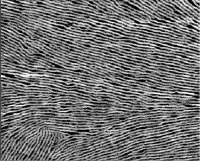Nanoscale Material Development
As more strain is placed on current energy supplies, due to increasing demand, solar energy will become an indispensable addition to available energy resources. The most promising candidate for large-scale economical power generation is the organic photovoltaic device (OPV), due to the low cost of materials, and fabrication methods with the same theoretical efficiency as conventional semiconductor devices. Research conducted in different groups has provided clear evidence that the progress of the OPVs technology is driven by the improvement in materials optoelectronic properties, such as light-harvesting, morphology and charge transport. Head-to-tail regioregular poly(3-alkylthiophenes) (rrPATs) have been widely used in OPVs due to their superior charge mobility. Studies of the relationship between the rrPAT films morphology and their charge mobility clearly suggested that the more ordered structures led to higher charge mobility. Although rrPAT can form ordered crystalline structures in the short range, long range ordered crystalline structures are critical in improving OPV efficiency, since the shorter diffusion path associated with longer range crystalline structures will reduce the recombination of electrons and holes, increasing the OPV efficiency. While various approaches have been employed to improve the ordering of rrPAT self-assembly structures, little is known about how the orientation can be optimized to obtain higher charge mobility.

In the research supported by a NSF CAREER Award, highly ordered conductive polymer supramolecular assemblies will be fabricated using rrPAT that ends with hydrogen bond donors and acceptors, as well as disc-like triphenylene rrPAT star polymers (see Figure 1). These self-assembled structures will be designed to achieve high charge mobility and large interfacial area when mixed with electron acceptors (i.e. fullerene) to assist the charge separation and charge transportation. The research will include synthesizing functional conductive homopolymers, fabricating ordered supramolecular assemblies, examining the charge mobility of the assemblies, studying the polymer/electron acceptor interfacial properties, building OPV devices and checking device efficiency. This research will provide optimized conductive polymer structures for charge transfer, knowledge on the relationship between molecular structures, solid assemblies and electrical properties, offer rational and predictable design rules for fabricating conductive polymer structures with desired properties for organic electronics, and realize efficient OPVs. The educational program will involve the development of a new undergraduate /graduate course (Renewable Energy), a demonstration module for energy conversion and generation, as well as research opportunities at the NanoScience Technology Center at the University of Central Florida.
For More Information
Dr. Lei Zhai
NanoScience Technology Center
University of Central Florida
Orlando, FL 32826